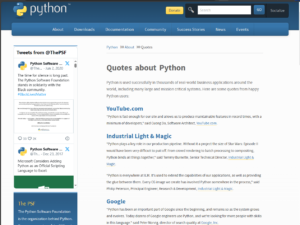What Is Python? – What Can You Do With Python Language
Questions like what is python software? what does python language do? what%20is%20%%20python? is python a free tool? what can python be used for? What Can You Do With Python langauge? python meaning in computer? where python is used? is python free to use etc.
The good news here is that I am here to answer all your question and what you really need to know about the Python Language.
What Is Python?
Python is a popular programming language that was created by Guido van Rossum and released in 1991. It is a versatile language that can be used for various purposes such as web development, software development, mathematics, and system scripting.
Python’s Primary Purpose
The primary purpose of Python is to provide a language that is easy to learn and read, with a simple syntax similar to the English language. It was designed to be beginner-friendly and to promote code readability, making it accessible to both novice and experienced programmers.
Early Development on Python
It’s development started in the late 1980s, and the first version, Python 0.9.0, was released in 1991. The language was influenced by several programming languages, including ABC, Modula-3, C, and Unix shell scripting. Guido van Rossum aimed to create a language that combined the best features of these languages while being easy to use and understand.
Version History and Improvements:
- Python 1:
- The initial release of Python, Python 1.0, came out in 1994. It introduced many fundamental features of the language, including the use of indentation for code blocks and the concept of modules and packages.
- Python 2:
- Python 2.0 was released in 2000 and brought significant improvements to the language, such as list comprehensions, garbage collection, and a more efficient way of handling Unicode. Python 2.7, released in 2010, became the last major version of Python 2, and it is still used by some legacy systems.
- Python 3:
- Python 3.0, also known as Python 3000, was released in 2008. It introduced several backward-incompatible changes to the language to address design flaws and improve consistency. Python 3 focused on improving Unicode support, simplifying the language syntax, and enhancing the overall performance of the interpreter. Python 3 is the current major version of Python and is widely adopted by the Python community.
Python’s popularity and adoption have continued to grow over the years due to its simplicity, versatility, and extensive library support. It has become one of the most widely used programming languages in various domains, including web development, data analysis, machine learning, and scientific computing.
SEE NOW: How to Optimize Instagram Content to Boost Visibility and Reach
What Can You Do With Python?
Without taking much of the time here in this post I will like you to quickly check below to see What You can Do With Python Software:
Data Analysis and Machine Learning
It offers a variety of libraries and tools, such as NumPy, Pandas, and scikit-learn, that enable data analysts and scientists to manipulate and analyze data, build machine learning models, and create data visualizations. Python’s simplicity and readability make it an ideal language for working with large datasets and implementing complex algorithms.
Web Development
Python is widely used in web development, both for the back end and front end. Frameworks like Django and Flask provide developers with powerful tools for building web applications, handling data, and managing server-side operations. It’s ease of use and extensive libraries make it a popular choice for developing scalable and robust web applications.
Automation and Scripting
With its simple syntax and extensive standard library, it allows users to write scripts that can automate tasks like file manipulation, data processing, web scraping, and more. It’s versatility and cross-platform compatibility make it an excellent choice for automating various processes.
Software Testing and Prototyping
Python is also used for software testing and prototyping. Its simplicity and readability make it easy to write test scripts and automate the testing process. Frameworks like PyTest and unittest provide developers with powerful tools for writing and executing tests. Additionally, its quick prototyping capabilities make it a preferred language for developing proof-of-concept applications.
Scientific Computing and Research:
Python is widely used in scientific computing and research. Libraries like SciPy and NumPy provide powerful tools for scientific calculations, simulations, and data analysis. Its integration with other scientific libraries, such as Matplotlib and Pandas, makes it a popular choice among researchers and scientists. Its ability to handle complex mathematical operations and visualize data makes it an essential tool in various scientific fields.
Artificial Intelligence and Natural Language Processing:
Python is extensively used in the field of artificial intelligence (AI) and natural language processing (NLP). Libraries like TensorFlow and Keras provide developers with the tools to build and train deep learning models for tasks like image recognition, speech recognition, and natural language understanding. It’s simplicity and the availability of pre-trained models make it a preferred language for AI and NLP applications.
However, like any programming language, it has its pros and cons. In this article, we will explore both the advantages and disadvantages of Python programming language.

Pros:
Easy to Learn and Readable Syntax:
Python has a simple and readable syntax that resembles English, making it easy for beginners to learn and understand. The code is clean and concise, which reduces the learning curve and makes it easier to maintain and debug.
Versatility:
Python is a versatile language that can be used for a wide range of applications, including web development, data analysis, machine learning, artificial intelligence, scientific computing, and more. It offers a rich set of libraries and frameworks that simplify development in various domains.
Library:
It comes with a large standard library that provides a comprehensive range of modules and functions for tasks. This eliminates the need to write code from scratch and accelerates development. The standard library includes modules for file handling, networking, regular expressions, and more.
Third-Party Libraries and Packages:
Python has a vast ecosystem of third-party libraries and packages available through the Python Package Index (PyPI). These libraries extend the functionality and provide solutions for specific tasks. Popular libraries like NumPy, Pandas, TensorFlow, and Django have contributed to Its popularity in data science, machine learning, and web development.
Strong Community Support:
It has a large and active community of developers who contribute to its growth and provide support through forums, online communities, and open-source projects. This community-driven approach ensures that developers can easily find help, resources, and solutions to their problems.
Cross-Platform Compatibility:
Python is a cross-platform language, meaning that programs can run on different operating systems without any modifications. This makes it easier to develop and deploy applications on multiple platforms, including Windows, macOS, and Linux.
Rapid Development:
The language’s high-level abstractions and built-in data structures allow developers to write code quickly and efficiently. Its interpreted nature eliminates the need for compilation, enabling developers to test and run code instantly.
Cons:
Performance:
Python is an interpreted language, which means it can be slower compared to compiled languages like C or Java. The interpreter needs to execute each line of code at runtime, resulting in slower execution speed. However, it offers ways to optimize performance, such as using libraries written in C or utilizing just-in-time (JIT) compilers.
Memory Consumption:
Dynamic typing and automatic memory management can lead to higher memory consumption compared to languages with manual memory management. This can be an issue when working with bigger datasets or in low-memory environments.
Global Interpreter Lock (GIL):
It has a Global Interpreter Lock (GIL) that allows only one thread to execute bytecode at a time. This can limit the performance of multi-threaded applications, as it prevents true parallel execution. However, the GIL is designed to simplify memory management and protect against race conditions.
Design Limitations:
Design choices may not be suitable for all use cases. For example, its whitespace indentation for code blocks can be a source of frustration for developers accustomed to using braces or brackets. Additionally, its lack of strict typing can lead to potential runtime errors that would be caught by a compiler in statically typed languages.
Despite these limitations, this programming language’s advantages outweigh its disadvantages for many developers and organizations. Its simplicity, versatility, and strong community support make it a popular choice for a wide range of applications.
If in case you still wish to know more about Python, then you can as well proceed to check out their website. https://www.python.org/
Continue reading: 10 Tips for Healthy and Nourishing Meal Preparations

